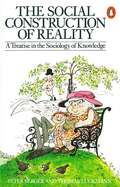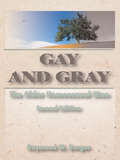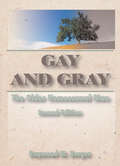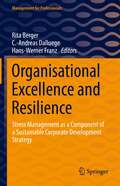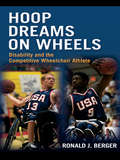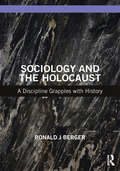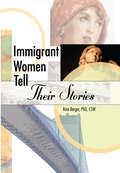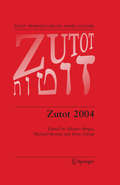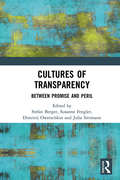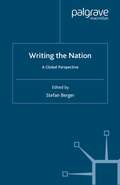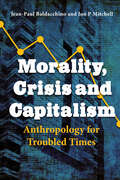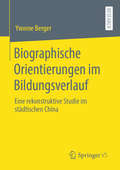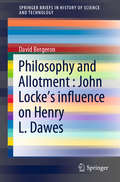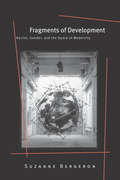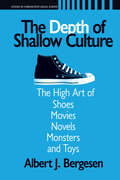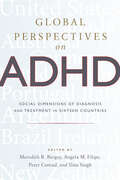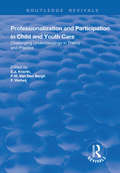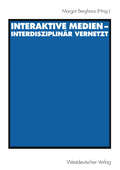- Table View
- List View
Transnationalisierung sozialer Ungleichheit (Sozialstrukturanalyse)
by Peter A. Berger Anja WeißDie Unterstellung, dass die Grenzen der Gesellschaft und die des Nationalstaats identisch sind, ist vor allem angesichts qualitativ und quantitativ veränderter Migrationsbewegungen in die Kritik geraten. Vor diesem Hintergrund wollen die in diesen Band aufgenommenen Beiträge von Maurizio Bach, Ulrich Beck, Michael Braun, Michael Hartmann, Eleonore Kofman, Bettina Mahlert, Steffen Mau, Jan Mewes, Gerd Nollmann, Ludger Pries, Ettore Recchi, Leslie Sklair, Anton Sterbling und Roland Verwiebe die Grenzen eines „methodologischen Nationalismus“ (U. Beck) sowohl in theoretisch-konzeptioneller wie auch in empirischer Hinsicht überwinden und dabei Antworten auf die Frage geben, was die Sozialstrukturanalyse gewinnt, wenn sie sich für transnationale Perspektiven öffnet.
The Social Construction of Reality: A Treatise in the Sociology of Knowledge (Penguin Social Sciences Ser.)
by Peter L. Berger Thomas LuckmannA general and systematic account of the role of knowledge in society aimed to stimulate both critical discussion and empirical investigations.This book is concerned with the sociology of ‘everything that passes for knowledge in society’. It focuses particularly on that ‘common-sense knowledge’ which constitutes the reality of everyday life for the ordinary member of society.The authors are concerned to present an analysis of knowledge in everyday life in the context of a theory of society as a dialectical process between objective and subjective reality. Their development of a theory of institutions, legitimations and socializations has implications beyond the discipline of sociology, and their ‘humanistic’ approach has considerable relevance for other social scientists, historians, philosophers and anthropologists.
Gay and Gray: The Older Homosexual Man, Second Edition
by Raymond BergerIn the absence of accurate information, American culture has upheld a distorted view of what it means to be an older gay man. Gay and Gray is the first and only scholarly full-length treatment of older gay men in America today. It breaks the stereotype that older gay men are strange, lonely creatures and reveals that most older gay men are well-adjusted to their homosexuality and the aging process.This second edition contains four new chapters that present additional perspectives on the reality of gay aging. Dr. Minnigerode&’s study shows that older gay men do not perceive themselves as growing old faster than their heterosexual counterparts, and that forty is the age at which most gay men believe that the label “young” no longer applies--this finding led Berger and other researchers to define “older” gay men as those over forty. Pope and Schulz confirm Berger&’s finding that for most older gay men a continuation of sexual activity and sexual enjoyment is the norm. John Grube&’s paper on the interaction of older gay men with younger gay liberationists explores the cultural divide between today&’s older gay man and his younger counterpart, filling a gap left in the first edition. And a concluding chapter by Richard Friend on a theory of successful gay aging summarizes much of the current thinking about this topic. The true situation of the older homosexual male presented in Gay and Gray challenges preconceptions about what it means to be old and gay. It asserts that in most ways, older gay men are indistinguishable from other older people. Because the book portrays older gay men in a realistic and sympathetic light, it is therapeutic for the many gay men who have been burdened with society&’s negative and distorted views about them. These men may compare their own lives to those of the respondents described in the book. Gay and Gray offers younger gay men a rare glimpse into their futures and enlightens and comforts those who count older gay men among their family and friends. The conclusions drawn in the book will change people&’s perspectives and offer new ways of thinking for and about older gay men.Gay and Gray is filled with rich case histories and treats its subject with dignity and compassion. Topics of focus include: love relationships social and psychological adjustment gay community self-acceptance being ”in the closet” and ”coming out” as a gay person intergenerational attitudes popular stereotypesAs the first intensive interview and questionnaire study of gay men aged 40 and older in America, Gay and Gray examines the lives of these men in light of cultural stereotypes. Author Berger asks about the social lives of these men, their involvement in both the heterosexual and homosexual communities, their ”coming out” experiences, their attitudes about younger gays, their experiences in growing older, and their strategies for adapting to life&’s challenges. In the study, Berger reveals that, contrary to stereotypic views, most older gay men are well-integrated into social networks and lead active and generally satisfying lives. He found that few live alone; most scored as well as younger gays on measures of psychological adjustment, such as self-acceptance; many are open about their homosexuality with family, friends, and colleagues; and the most well-adjusted older gay men were integrated into a homosexual community, associated with younger gay men, and were unwilling to change their sexual orientation.
Gay and Gray: The Older Homosexual Man, Second Edition
by Raymond BergerIn the absence of accurate information, American culture has upheld a distorted view of what it means to be an older gay man. Gay and Gray is the first and only scholarly full-length treatment of older gay men in America today. It breaks the stereotype that older gay men are strange, lonely creatures and reveals that most older gay men are well-adjusted to their homosexuality and the aging process.This second edition contains four new chapters that present additional perspectives on the reality of gay aging. Dr. Minnigerode&’s study shows that older gay men do not perceive themselves as growing old faster than their heterosexual counterparts, and that forty is the age at which most gay men believe that the label “young” no longer applies--this finding led Berger and other researchers to define “older” gay men as those over forty. Pope and Schulz confirm Berger&’s finding that for most older gay men a continuation of sexual activity and sexual enjoyment is the norm. John Grube&’s paper on the interaction of older gay men with younger gay liberationists explores the cultural divide between today&’s older gay man and his younger counterpart, filling a gap left in the first edition. And a concluding chapter by Richard Friend on a theory of successful gay aging summarizes much of the current thinking about this topic. The true situation of the older homosexual male presented in Gay and Gray challenges preconceptions about what it means to be old and gay. It asserts that in most ways, older gay men are indistinguishable from other older people. Because the book portrays older gay men in a realistic and sympathetic light, it is therapeutic for the many gay men who have been burdened with society&’s negative and distorted views about them. These men may compare their own lives to those of the respondents described in the book. Gay and Gray offers younger gay men a rare glimpse into their futures and enlightens and comforts those who count older gay men among their family and friends. The conclusions drawn in the book will change people&’s perspectives and offer new ways of thinking for and about older gay men.Gay and Gray is filled with rich case histories and treats its subject with dignity and compassion. Topics of focus include: love relationships social and psychological adjustment gay community self-acceptance being ”in the closet” and ”coming out” as a gay person intergenerational attitudes popular stereotypesAs the first intensive interview and questionnaire study of gay men aged 40 and older in America, Gay and Gray examines the lives of these men in light of cultural stereotypes. Author Berger asks about the social lives of these men, their involvement in both the heterosexual and homosexual communities, their ”coming out” experiences, their attitudes about younger gays, their experiences in growing older, and their strategies for adapting to life&’s challenges. In the study, Berger reveals that, contrary to stereotypic views, most older gay men are well-integrated into social networks and lead active and generally satisfying lives. He found that few live alone; most scored as well as younger gays on measures of psychological adjustment, such as self-acceptance; many are open about their homosexuality with family, friends, and colleagues; and the most well-adjusted older gay men were integrated into a homosexual community, associated with younger gay men, and were unwilling to change their sexual orientation.
Organisational Excellence and Resilience: Stress Management as a Component of a Sustainable Corporate Development Strategy (Management for Professionals)
by Rita Berger C. Andreas Dalluege Hans-Werner FranzPersonal stress has an enormous impact on organizational and employee performance. This book introduces the web-based diagnostic tool IMPRESS, which provides employees, managers and HR professionals with information about potential stress factors. The book describes the underlying methodology for this integrated approach and presents the tools and learning modules to support the methodology. A series of case studies from pilot implementations in companies and universities illustrate the application of the approach in a variety of work environments. The book is based on an international research project for a holistic approach to stress prevention by combining Human Systems Audit with the European Excellence approach as promoted by the Common Assessment Framework (CAF) and the EFQM Excellence Model. This approach is intended to contribute to organizational development that supports effective employee stress management.
Hoop Dreams on Wheels: Disability and the Competitive Wheelchair Athlete (Sociology Re-Wired)
by Ronald BergerHoop Dreams on Wheels is a life-history study of wheelchair athletes associated with a premier collegiate wheelchair basketball program. The book, which grapples with the intersection of biography and history in society, situates the study in broader context with background on the history and sociology of disability and disability sports. It documents the development and evolution of the basketball program and tells the individual life stories of the athletes, highlighting the formative interpersonal and institutional experiences that influenced their agentive actions and that helped them achieve success in wheelchair sports. It also examines divisions within the disability community that reveal both empowering and disempowering aspects of competitive wheelchair athletics, and it explores some of the complexities and dilemmas of disability identity in contemporary society. The book is intended to be read by a general audience as well as by students in college courses on disability, sports, social problems, deviance, medical sociology and anthropology, and introductory sociology. It also will be of interest to scholars in the sociology of disability, sociology of sports, and medical humanities, as well as life-history researchers and professionals in the fields of physical education, therapeutic recreation, and rehabilitative counseling.
Hoop Dreams on Wheels: Disability and the Competitive Wheelchair Athlete (Sociology Re-Wired)
by Ronald BergerHoop Dreams on Wheels is a life-history study of wheelchair athletes associated with a premier collegiate wheelchair basketball program. The book, which grapples with the intersection of biography and history in society, situates the study in broader context with background on the history and sociology of disability and disability sports. It documents the development and evolution of the basketball program and tells the individual life stories of the athletes, highlighting the formative interpersonal and institutional experiences that influenced their agentive actions and that helped them achieve success in wheelchair sports. It also examines divisions within the disability community that reveal both empowering and disempowering aspects of competitive wheelchair athletics, and it explores some of the complexities and dilemmas of disability identity in contemporary society. The book is intended to be read by a general audience as well as by students in college courses on disability, sports, social problems, deviance, medical sociology and anthropology, and introductory sociology. It also will be of interest to scholars in the sociology of disability, sociology of sports, and medical humanities, as well as life-history researchers and professionals in the fields of physical education, therapeutic recreation, and rehabilitative counseling.
Sociology and the Holocaust: A Discipline Grapples with History
by Ronald J BergerFor some time the conventional wisdom in the interdisciplinary field of Holocaust studies is that sociologists have neglected this subject matter, but this is not really the case. In fact, there has been substantial sociological work on the Holocaust, although this scholarship has often been ignored or neglected including in the discipline of sociology itself. Sociology and the Holocaust brings this scholarly tradition to light, and in doing so offers a comprehensive synthesis of the vast historical and social science literature on the before, during, and after of the Holocaust—a tour d’horizon from an explicitly sociological perspective. As such, the aim of the book is not simply to describe the chronology of events that culminated in the deaths of 6 million Jews but to draw upon sociology’s “theoretical toolkit” to understand these events and the ongoing legacy of the Holocaust sociologically.
Sociology and the Holocaust: A Discipline Grapples with History
by Ronald J BergerFor some time the conventional wisdom in the interdisciplinary field of Holocaust studies is that sociologists have neglected this subject matter, but this is not really the case. In fact, there has been substantial sociological work on the Holocaust, although this scholarship has often been ignored or neglected including in the discipline of sociology itself. Sociology and the Holocaust brings this scholarly tradition to light, and in doing so offers a comprehensive synthesis of the vast historical and social science literature on the before, during, and after of the Holocaust—a tour d’horizon from an explicitly sociological perspective. As such, the aim of the book is not simply to describe the chronology of events that culminated in the deaths of 6 million Jews but to draw upon sociology’s “theoretical toolkit” to understand these events and the ongoing legacy of the Holocaust sociologically.
Immigrant Women Tell Their Stories
by Roni Berger"I felt like an alien who fell down to earth, not understanding the rules of the game, making all the possible mistakes, saying all the wrong things." "Your whole life is in the hands of other people who do not always mean well and there is nothing you can do about it. They can decide to send you away and you have no control." "The moment I enter the house, I shelve my American self and become the 'little obedient wife' that my husband wants me to be." "The most difficult part is to find myself again. At the beginning I lost myself." This jargon-free book documents and analyzes the experience of immigration from the female perspective. It discusses the unique challenges that women face, offers insights into the meanings of their experiences, develops gender-sensitive knowledge about immigration, and discusses implications for the effective development and provision of services to immigrant women. With fascinating case studies of immigration to the United States, Australia, and Israel as well as helpful lists of relevant organizations and Web site/Internet addresses, Immigrant Women Tell Their Stories is for everyone who wants to learn or teach about immigration, especially its female face. "It was like somebody sawed my heart in two. One part remained in Cuba and one part here." Immigrant Women Tell Their Stories examines the nature of immigration for women through the eyes of those who have experienced it: how they perceive, interpret, and address the nature of the experience, its multiple aspects, the issues that it presents, and the strategies that immigrant women develop to cope with those issues. The women in this extraordinary book came from different spots around the globe, speak different languages and dialects, and their English comes in different accents. They vary in age as well as in cultural, ethnic, social, educational, and professional status. They represent a rainbow of family types and political opinions. In spite of their diversity, all these women share immigration experience. This book provides an understanding of the journeys they traveled and the experiences they lived to bring you new insights into what it means to immigrate as a woman and to frame effective strategies for working with-and for-immigrant women. "My father is the head of the house. When he decided to move to America [from India] my mother and us, the daughters, did not have much say. My mother and I were not happy at all, but it did not matter." Immigrant Women Tell Their Stories provides you with historical and global perspectives on immigration and addresses: legal, political, economic, social, and psychological dimensions of immigration and its aftermath deconstructing immigration by age, gender, and circumstances major issues of immigrant women-language, mothering, relationships and marriage, finding employment, assimilation (how much and how soon), loneliness, and more resilience in immigrant women immigration from a lesbian perspective guidelines for the development and delivery of services to immigrant women "You may say that I am the bridge, the desert generation that lost the chance to have it my way. But I will do my best to raise my daughters to have more choices than I." In this well-referenced book, immigrant women from Austria, Bosnia, Cuba, various parts of the former Soviet Union, Guatemala, India, Israel, Lebanon, Mexico, Pakistan, and the Philippines tell us their stories, recount what their experiences entailed and what challenges they posed, and teach us ways to help them cope successfully. "This was the best decision we could have made and the best thing we had ever done."
Immigrant Women Tell Their Stories
by Roni Berger"I felt like an alien who fell down to earth, not understanding the rules of the game, making all the possible mistakes, saying all the wrong things." "Your whole life is in the hands of other people who do not always mean well and there is nothing you can do about it. They can decide to send you away and you have no control." "The moment I enter the house, I shelve my American self and become the 'little obedient wife' that my husband wants me to be." "The most difficult part is to find myself again. At the beginning I lost myself." This jargon-free book documents and analyzes the experience of immigration from the female perspective. It discusses the unique challenges that women face, offers insights into the meanings of their experiences, develops gender-sensitive knowledge about immigration, and discusses implications for the effective development and provision of services to immigrant women. With fascinating case studies of immigration to the United States, Australia, and Israel as well as helpful lists of relevant organizations and Web site/Internet addresses, Immigrant Women Tell Their Stories is for everyone who wants to learn or teach about immigration, especially its female face. "It was like somebody sawed my heart in two. One part remained in Cuba and one part here." Immigrant Women Tell Their Stories examines the nature of immigration for women through the eyes of those who have experienced it: how they perceive, interpret, and address the nature of the experience, its multiple aspects, the issues that it presents, and the strategies that immigrant women develop to cope with those issues. The women in this extraordinary book came from different spots around the globe, speak different languages and dialects, and their English comes in different accents. They vary in age as well as in cultural, ethnic, social, educational, and professional status. They represent a rainbow of family types and political opinions. In spite of their diversity, all these women share immigration experience. This book provides an understanding of the journeys they traveled and the experiences they lived to bring you new insights into what it means to immigrate as a woman and to frame effective strategies for working with-and for-immigrant women. "My father is the head of the house. When he decided to move to America [from India] my mother and us, the daughters, did not have much say. My mother and I were not happy at all, but it did not matter." Immigrant Women Tell Their Stories provides you with historical and global perspectives on immigration and addresses: legal, political, economic, social, and psychological dimensions of immigration and its aftermath deconstructing immigration by age, gender, and circumstances major issues of immigrant women-language, mothering, relationships and marriage, finding employment, assimilation (how much and how soon), loneliness, and more resilience in immigrant women immigration from a lesbian perspective guidelines for the development and delivery of services to immigrant women "You may say that I am the bridge, the desert generation that lost the chance to have it my way. But I will do my best to raise my daughters to have more choices than I." In this well-referenced book, immigrant women from Austria, Bosnia, Cuba, various parts of the former Soviet Union, Guatemala, India, Israel, Lebanon, Mexico, Pakistan, and the Philippines tell us their stories, recount what their experiences entailed and what challenges they posed, and teach us ways to help them cope successfully. "This was the best decision we could have made and the best thing we had ever done."
Zutot 2004 (Zutot: Perspectives on Jewish Culture #4)
by Shlomo Berger M. Brocke I. E. ZwiepThe yearbook Zutot serves as a platform for small but incisive contributions on Jewish Studies. It covers Jewish Culture in its broadest sense, encompassing various academic disciplines such as literature, languages and linguistics, philosophy, art, sociology, politics, and history. It also reflects binary oppositions such as religious and secular, high and low, written and oral, male and female culture.
Cultures of Transparency: Between Promise and Peril
by Stefan BergerThis volume addresses the major questions surrounding a concept that has become ubiquitous in the media and in civil society as well as in political and economic discourses in recent years, and which is demanded with increasing frequency: transparency. How can society deal with increasing and often diverging demands and expectations of transparency? What role can different political and civil society actors play in processes of producing, or preventing, transparency? Where are the limits of transparency and how are these boundaries negotiated? What is the relationship of transparency to processes of social change, as well as systems of social surveillance and control? Engaging with transparency as an interrelated product of law, politics, economics and culture, this interdisciplinary volume explores the ambiguities and contradictions, as well as the social and political dilemmas, that the age of transparency has unleashed. As such it will appeal to researchers across the social sciences and humanities with interests in politics, history, sociology, civil society, citizenship, public policy, criminology and law.
Writing the Nation: A Global Perspective
by Stefan BergerThis book brings together experts on national history writing from all five continents to discuss the role of history in the making of national identities in a transnational and comparative way. The institutionalization and professionalisation of history writing is analysed in the context of history's increasing nationalization.
Cultures of Transparency: Between Promise and Peril
by Stefan Berger Susanne Fengler Dimitrij Owetschkin Julia SittmannThis volume addresses the major questions surrounding a concept that has become ubiquitous in the media and in civil society as well as in political and economic discourses in recent years, and which is demanded with increasing frequency: transparency. How can society deal with increasing and often diverging demands and expectations of transparency? What role can different political and civil society actors play in processes of producing, or preventing, transparency? Where are the limits of transparency and how are these boundaries negotiated? What is the relationship of transparency to processes of social change, as well as systems of social surveillance and control? Engaging with transparency as an interrelated product of law, politics, economics and culture, this interdisciplinary volume explores the ambiguities and contradictions, as well as the social and political dilemmas, that the age of transparency has unleashed. As such it will appeal to researchers across the social sciences and humanities with interests in politics, history, sociology, civil society, citizenship, public policy, criminology and law.
Morality, Crisis and Capitalism: Émigré Scholars and the Production of Historical Knowledge in the 20th Century
by Stefan Berger Philipp MüllerAs a pioneering volume to consider the impact of exile on historical scholarship in the twentieth century in a systematic and global way, looking at Europe, North America, South America and Asia, Dynamics of Emigration asks about epistemic repercussions on the experience of exile and exiles. Analyzing both the impact that exile scholars had on their host societies and on the societies they had to leave, the volume investigates exiles’ pathways to integration into new host societies and the many difficulties they face establishing themselves in new surroundings. Focusing on the age of extremes and the realms of exile from fascist and right-wing dictatorships as well as communist regimes, the contributions look at the reasons scholars have for going into exile while providing side-by-side examination of the support organizations and paths for success involved with living in exile.
Biographische Orientierungen im Bildungsverlauf: Eine rekonstruktive Studie im städtischen China
by Yvonne BergerYvonne Berger untersucht in einer rekonstruktiven Studie die sozialen und räumlichen Bedingungen universitärer Bildungsverläufe im städtischen China. Dabei fokussiert sie eine bislang qualitativ-empirisch wenig beforschte Gruppe, die sogenannten Bildungsaufsteigerinnen und -aufsteiger im Kontext des chinesischen Bildungssystems. Auf der Basis narrativ-biographischer Interviews widmet sich die Autorin insbesondere den biographischen Orientierungen junger Chinesinnen und Chinesen, indem sie die Bildungsstrategien sowie Aneignungs- und Reflexionsprozesse über die Phasen und Bildungsübergänge im Lebensverlauf empirisch in den Blick nimmt.
Philosophy and Allotment : John Locke's influence on Henry L. Dawes (SpringerBriefs in History of Science and Technology)
by David BergeronThis book provides a new perspective for examining the Native policies of the late nineteenth century. It centers on the figure of Henry Laurens Dawes, and more specifically, on the conceptual roots of his views on allotment, education and assimilation. These roots are grounded in John Locke’s epistemology and pedagogy. Through a philosophical analysis of Dawes’ ideas and policies, the book provides a new approach to arrive at a better understanding of an important historical process. In this regard, an often-overlooked link between philosophy and history is clarified, helping philosophers, historians and other scholars in their quest for knowledge. This book clarifies the impact of philosophical ideas on historical conceptions, and by studying Dawes, also addresses the reflection behind a major historical process. Political and social philosophers, as well as historians of ideas and of Native policies, will greatly benefit from this concise book.
Fragments of Development: Nation, Gender, and the Space of Modernity
by Suzanne BergeronBy tracing out the intersection between the imagined space of the national economy and the gendered construction of "expert" knowledge in development thought, Suzanne Bergeron provides a provocative analysis of development discourse and practice. By elaborating a framework of including/excluding economic subjects and activities in development economics, she provides a rich account of the role that economists have played in framing the contested political and cultural space of development. Bergeron's account of the construction of the national economy as an object of development policy follows its shifting meanings through modernization and growth models, dependency theory, structural adjustment, and contemporary debates about globalization and highlights how intersections of nation and economy are based on gendered and colonial scripts. The author's analysis of development debates effectively demonstrates that critics of development who ignore economists' nation stories may actually bolster the formation they are attempting to subvert. Fragments of Development is essential reading for those interested in development studies, feminist economics, international political economy, and globalization studies.
Depth of Shallow Culture: The High Art of Shoes, Movies, Novels, Monsters, and Toys
by Albert J. BergesenCome take a closer look at ordinary footwear, like sneakers, or children's toys and Saturday cartoon TV shows, or make a comparison between Don Quixote and John Rambo of the Sylvester Stallone movie. Although some regard popular culture as "shallow," this book reveals that it is more often complex, deep, meaningful and subject to the style changes we associate with high art. Bergesen shows how complex philosophical ideas of reincarnation are embedded in Transformer toys; how sneakers have gone through a life cycle of style types; why the decline of empires like Spain and the United States led to fictional characters like Don Quixote and Rambo; and why monsters from Japan look different than those from the United States.
Depth of Shallow Culture: The High Art of Shoes, Movies, Novels, Monsters, and Toys
by Albert J. BergesenCome take a closer look at ordinary footwear, like sneakers, or children's toys and Saturday cartoon TV shows, or make a comparison between Don Quixote and John Rambo of the Sylvester Stallone movie. Although some regard popular culture as "shallow," this book reveals that it is more often complex, deep, meaningful and subject to the style changes we associate with high art. Bergesen shows how complex philosophical ideas of reincarnation are embedded in Transformer toys; how sneakers have gone through a life cycle of style types; why the decline of empires like Spain and the United States led to fictional characters like Don Quixote and Rambo; and why monsters from Japan look different than those from the United States.
Global Perspectives on ADHD: Social Dimensions of Diagnosis and Treatment in Sixteen Countries
by Meredith R. Bergey Angela M. Filipe Peter Conrad Ilina SinghAttention deficithyperactivity disorder (ADHD) has been a common psychiatric diagnosis in both children and adults since the 1980s and 1990s in the United States. But the diagnosis was much less common;¢;‚¬;€?even unknown;¢;‚¬;€?in other parts of the world. By the end of the twentieth century, this was no longer the case, and ADHD diagnosis and treatment became an increasingly widespread global phenomenon. As the diagnosis was adopted around the world, the definition and treatment of ADHD often changed in the context of different psychiatric professions, medical systems, and cultures. Global Perspectives on ADHD is the first book to examine how this expanding public health concern is diagnosed and treated in 16 different countries. In some countries, readers learn, over 10% of school-aged children and adolescents are diagnosed with ADHD; in others, that figure is less than 1%. Some countries focus on medicating children with ADHD; others emphasize parent intervention or child therapy. Showing how a medical diagnosis varies across contexts and time periods, this book explains how those distinctions shape medical interventions and guidelines, filling a much-needed gap by examining ADHD on an international scale. Contributors: Madeleine Akrich, Mari J. Armstrong-Hough, Meredith R. Bergey, Eugenia Bianchi, Christian Br;¶er, Peter Conrad, Claire Edwards, Silvia A. Faraone, Angela M. Filipe, Alessandra Frigerio, Val;©ria Portugal Gon;§alves, Linda J. Graham, Hiroyuki Ito, Fabian Karsch, Victor Kraak, Claudia Malacrida, Lorenzo Montali, Yasuo Murayama, Sebasti;¡n Rojas Navarro, ;“rla O'Donovan, Francisco Ortega, M;³nica Pe;±a Ochoa, Brenton J. Prosser, Vololona Rabeharisoa, Patricio Rojas, Tiffani Semach, Ilina Singh, Rachel Spronk, Junko Teruyama, Masatsugu Tsujii, Fan-Tzu Tseng, Manuel Vall;©e, Rafaela Zorzanelli
Global Perspectives on ADHD: Social Dimensions of Diagnosis and Treatment in Sixteen Countries
by Meredith R. Bergey Angela M. Filipe Peter Conrad Ilina SinghAttention deficithyperactivity disorder (ADHD) has been a common psychiatric diagnosis in both children and adults since the 1980s and 1990s in the United States. But the diagnosis was much less common;¢;‚¬;€?even unknown;¢;‚¬;€?in other parts of the world. By the end of the twentieth century, this was no longer the case, and ADHD diagnosis and treatment became an increasingly widespread global phenomenon. As the diagnosis was adopted around the world, the definition and treatment of ADHD often changed in the context of different psychiatric professions, medical systems, and cultures. Global Perspectives on ADHD is the first book to examine how this expanding public health concern is diagnosed and treated in 16 different countries. In some countries, readers learn, over 10% of school-aged children and adolescents are diagnosed with ADHD; in others, that figure is less than 1%. Some countries focus on medicating children with ADHD; others emphasize parent intervention or child therapy. Showing how a medical diagnosis varies across contexts and time periods, this book explains how those distinctions shape medical interventions and guidelines, filling a much-needed gap by examining ADHD on an international scale. Contributors: Madeleine Akrich, Mari J. Armstrong-Hough, Meredith R. Bergey, Eugenia Bianchi, Christian Br;¶er, Peter Conrad, Claire Edwards, Silvia A. Faraone, Angela M. Filipe, Alessandra Frigerio, Val;©ria Portugal Gon;§alves, Linda J. Graham, Hiroyuki Ito, Fabian Karsch, Victor Kraak, Claudia Malacrida, Lorenzo Montali, Yasuo Murayama, Sebasti;¡n Rojas Navarro, ;“rla O'Donovan, Francisco Ortega, M;³nica Pe;±a Ochoa, Brenton J. Prosser, Vololona Rabeharisoa, Patricio Rojas, Tiffani Semach, Ilina Singh, Rachel Spronk, Junko Teruyama, Masatsugu Tsujii, Fan-Tzu Tseng, Manuel Vall;©e, Rafaela Zorzanelli
Professionalization and Participation in Child and Youth Care: Challenging Understandings in Theory and Practice
by P. M. Van Den Bergh F. Verheij E. J. KnorthThis title was first published in 2002. The field of child and youth care is under increasing pressure to optimize its mission: to deliver high quality support and to help children, parents and families in need of care. Two questions have arisen in many countries in the face of this pressure: the professional quality of childcare and the participant quality of childcare. These issues have traditionally been discussed separately; this unique book brings them together for an enlightening discussion. Examining the possible antagonism of childcare workers operating as professionals and clients participating as fully engaged partners, the book brings to light a new vision on developments and research in the field and informs the reader on recent findings. The expertise of the contributors makes this a truly valuable read for practitioners, policy makers, researchers and students in the field of child and youth care.
Interaktive Medien — interdisziplinär vernetzt
by Margot BerghausInteraktive Medien, Internet und Multimedia revolutionieren Wirtschaft, Technik, Gesellschaft, Kultur. Also sind sie Thema vieler wissenschaftlicher Disziplinen. In dem Reader werden interaktive Medien von neun verschiedenen Fachrichtungen untersucht: aus Sicht der Rechts-, Wirtschafts-, Erziehungs-, Sozial-, Kultur-, Medien- und Kommunikationswissenschaft, der Psychologie, Informatik und Wirtschaftsinformatik. Das Ergebnis ist ein breiter Überblick über den Gegenstand - vom Electronic Commerce über Medienrecht in der Informationsgesellschaft, Lernen durch Interaktivität usw. bis zur automatischen Videoanalyse.

